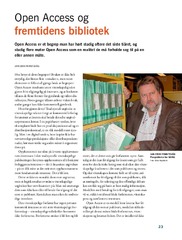Open Access og fremtidens bibliotek
Forfatter
Frantsvåg, Jan ErikSammendrag
Open Access entails making an academic text freely available online, including allowing the user most forms of reuse and further distribution. Sometimes all forms of use are permitted, other times only noncommercial
use is permitted. Copyright laws were established to protect the interests of the creator. In traditional academic publication,
copyrights are used to protect the interests of the publisher – to finance the publication – in such a way that it infringes upon the most fundamental interest
of the creator: Being read. Open Access is a model wherein readers can freely access what has been published; the model thus satisfies the needs of the author, of science, and of
the readers. However, this does not mean that Open Access publication is free of charge; publishers and other actors still perform key functions, which must be financed somehow. Commercial Open Access
publishers demand a fee for taking on the articles, and this fee is payable by the author’s clients. Many Open Access journals, on the other hand, operate on the basis of the patron model, where one institution takes
on the responsibility of hosting the journal, covering all of its fees. No Norwegian Open Access journals, and very few Nordic journals, require fees from authors.
There are currently 16 Open Access journals in Norway, of which 12 are accredited academic journals. There are an estimated 4500 Open Access journals worldwide.
Traditionally, the primary task of research libraries has been to find information for students and researchers. Perhaps the primary task of the research library in the future will be to work on finding readers for its students and researchers?


 English
English norsk
norsk